9 Free B2C Customer Journey Map Templates & How to Use Them
Discover the importance of B2C customer journey mapping and get access to 9 free templates for multiple customer engagement use cases.
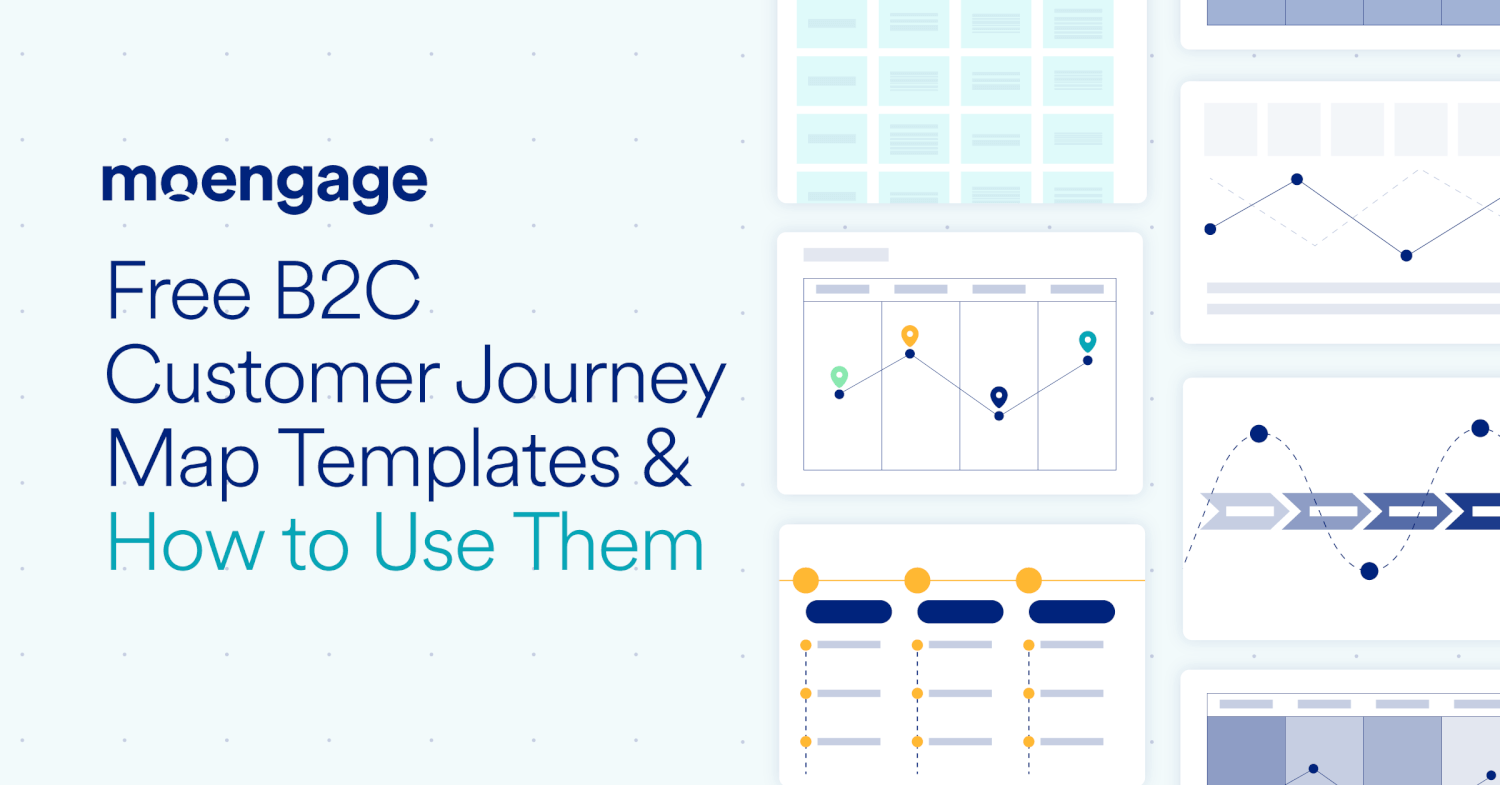
Reading Time: 13 minutes
In the ever-evolving world of B2C marketing, failing to consider the customer journey in your strategy can have dire consequences on your North Star metrics.
Consider Sarah, a seasoned B2C marketer tasked with promoting a new loyalty program for a high-end fashion brand during Halloween. Sarah was excited to launch this new campaign and did an excellent job with her choice of copy and creatives for their push notification and email campaigns.
However, she made a critical error. She overlooked how all these components fit into the overall customer journey and how best to leverage the campaigns she’d designed to engage customers effectively. The result was a subpar campaign execution and below-average engagement:
- Customers who had uninstalled the mobile app received an email about the perks of being a loyal customer. 😑
- Unhappy buyers who had given a negative review to the mobile app got a push notification asking them to refer their friends! 😡
- Customers with just one purchase over six months ago were informed about signing up for the loyalty program. 😖
Sarah’s eye-catching visuals and tailored copy text weren’t enough to save her campaign, and the loyalty program launch was disastrous, failing to activate customers at the right points in their customer journey.
As a B2C marketer, you have a pivotal role in shaping customers’ experiences with your brand. Unlike the B2B buying process, B2C shopping is all about speed and convenience. For B2C brands to succeed, they need to develop customer journey maps that empower customers to proceed through the buying process smoothly.
To help you craft engaging customer journeys that meet your consumers where they are, we explore what B2C customer journey mapping is and why it’s vital for B2C brands to maximize engagement. We also look at nine B2C customer journey map templates that brands can use to plan out customer journeys that engage customers effectively using MoEngage.
What is B2C Customer Journey Mapping?
B2C customer journey mapping is the process of designing customer journeys specifically for business-to-customer use cases. That means crafting intuitive customer experiences and campaigns that let customers transition between online and offline channels to interact seamlessly with your brand.
Unlike highly complex B2B customer journeys that require a lot of time spent nurturing the customer and conveying their value proposition, B2C needs to be more direct, fast, and engaging. Consumers still consider value propositions, but the buying process is much shorter and less deliberate. Your B2C customer journeys need to cut to the chase and elicit engagement quickly to drive B2C engagement.
What’s different about building a B2C customer journey map?
In general, B2C buying processes aim to be short and simple, intended to make it easy for a large number of customers to complete. While there are exceptions, such as furniture, an air conditioning repair, or a family trip, most consumer purchases don’t have a labor-intensive consideration or comparison process (as B2B businesses would).
Although not true of every industry, B2C customer journeys are therefore focused more on driving quick conversions and immediate sales than driving long-term value. While still important, retention isn’t as vital to B2C brands as it is to B2B brands that rely on a lower volume of higher value clients.
Consumer-facing brands can reach out via more personal channels, like mobile push and SMS messaging. They also have a lot more freedom in matching the tone of their messaging to reflect their brand’s style, image, and vision.
Typically, B2B customer journey mapping is a more complex process, as B2B sales often involve multiple decision-makers. You don’t just have to convince a single customer you’re the best option, you have to convince key figures in multiple departments, all of whom have different goals and objectives. Since B2B brands need to craft journeys that ensure all these stakeholders are in alignment, the B2B buying process is much more intensive, exhaustive, and time-consuming.
In contrast, B2C marketers are dealing with individuals that are often looking for a quick solution. Since they make their own decision, there is often less time spent on consideration and comparisons, and the overall decision -making process is much simpler and faster. And to facilitate this pace, B2C brands need to make sure they map customer journeys that are just as fast and simple.
Why do B2C marketers need to do customer journey mapping?
For brands to succeed in the modern consumer-centric environment, they need to be able to connect with their customers in a meaningful way. To do this, they need to use channels, timing, and messaging that resonates with their customers — and motivates them to interact with their brand.
When running an omnichannel marketing strategy, these things don’t naturally fall into place, they need to be carefully mapped out. But having clearly laid out customer pathways enables brands to engage customers effectively throughout the entire process, no matter where their customers enter or exit the journey.
Customer journey mapping helps B2C marketers do the following:
- Establish a customer-centric approach: Mapping customer journeys allows you to build your brand experience around your customers by understanding and accounting for their needs, emotions, and most common pain points.
- Improve the customer experience: Clearly defined customer journeys allow you to identify pain points in the experience so you can make meaningful improvements that enhance the customer’s experience.
- Increase ROI from your campaigns: Squeeze more value out of your campaigns by using as many touchpoints in your customer journeys, deploying the right channel at the right time to maximize your conversion rate.
- Reduce abandonment and drop-off rates: Understanding where drop-offs occur most in the customer journey allows you to not only isolate abandonment, but also understand why it’s happening and make an adequate fix.
- Streamline the onboarding process: Create intuitive pathways that help you attract and onboard customers effectively and efficiently, eliminating as many blockers as possible along the way.
- Increase customer retention: Keeping customers satisfied at every step of their journey ensures they stick around for more. Effective journey mapping enables you to keep customers motivated and engaged consistently.
- Make data-driven decisions: With detailed data on customer demographics, activity, and behavior, you can design carefully crafted customer journeys that are rooted in what your costumes actually want from their shopping experience.
- Gain a competitive advantage: By investing in B2C journey mapping, brands provide a superior experience to their competition, ensuring customers choose their brand (and continue to come back for more).
5 B2C Customer Journey Stages to Consider While Mapping
While B2C brands are typically focused most on interacting with customers at pivotal inflection points that are ideally suited for triggering a conversion event, it’s crucial to engage customers throughout their entire journey to keep their attention.
In general, the customer journey can be broken down into 5 main stages that trace the customer experience from a potential customer who has never heard of your brand all the way to a devout loyalist who will advocate on your brand’s behalf.
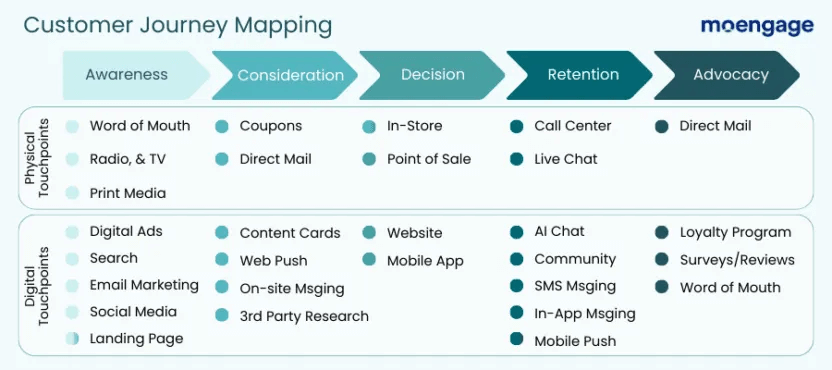
Remember, customer journeys are nuanced, diverse, and complex; especially omnichannel ones. Customers can (and will) enter and exit the journey at various points, rarely following it cleanly from beginning to end. It’s your job to make sure that the journey remains accessible no matter which point the customer enters, and have campaigns that cycle customers back to previous steps depending on where they enter.
Below, we look at the 5 main customer journey stages and how they apply to B2C marketers and brands.
| Customer Journey Stage | How This Stage is Different in B2C |
| 1. Awareness: The customer becomes familiar with your brand. | Rather than hyper-fixating on qualified leads, B2C marketers cast a wide net to generate attention and attract customers, while still personalizing campaigns enough to resonate with their audience. |
| 2. Consideration: The customer is reviewing their options for a brand, product, or service. | People buying low-cost items, ordering food, or consuming entertainment content are looking to make a quick decision about what they want. B2C marketers have a short window to convince them to choose their brand, and need to make the most of each brief interaction. |
| 3. Decision: The customer makes a choice on what to purchase. | The decision-making process for B2C is extremely fast, with consumers often making a decision on the spot. Brands should focus on quickly explaining why they’re the right choice for the customer and making it easy for customers to complete their order. |
| 4. Retention: The customer decides if they want to keep using the brand, product, or service. | While retail and ecommerce brands will be more heavily focused on conversions, B2C brands that sell subscriptions or ad-space will be far more focused on retention to drive their customer lifetime value (CLV). Either way, retention is incredibly important for B2C brands looking to grow their company sustainably at scale. |
| 5. Advocacy: The customer will make a recommendation to others. | B2C brands often rely less on word-of-mouth than B2B brands. Despite the fact that referrals aren’t as critical for B2C brands, brand advocacy is still crucial for developing a good public image and solid brand recognition for a brand. |
9 Free B2C Customer Journey Map Templates for Marketers
Failing to consider the customer journey while building your campaigns can lead to disconnected experiences and poor results. But crafting a comprehensive customer journey from scratch — one that considers all potential points of interaction — is no easy task.
Fortunately, we’ve already started for you! To help B2C brands map out their customer journeys, we’ve created 9 pre-built, easy-to-follow templates for inspiration.
Each one can be customized to fit your unique industry, niche, or use case. Whether you’re looking to develop onboarding journeys or purchase funnels, these templates serve as an ideal starting point to help you build intricate, detailed omnichannel customer journeys that enable customers to flow seamlessly across all channels.
The customer journey templates provided below use our core Flows features to help you create personalized experiences, including Intelligent Path Optimizer (IPO) that lets you A/B test up to five different branches and Next Best Action (NBA) that uses omnichannel data to select the best channel and time to engage each customer.
Together, these help brands achieve high conversion rates by providing seamless experiences across multiple touchpoints.
1. Single-channel Customer Onboarding Flow
Simplifying your new customer’s onboarding journey is naturally your top priority. By using a single communication channel, such as Email, SMS, or Push Notifications (Mobile App or Website), you can streamline the onboarding process and ensure that a seamless experience greets your new customers.
| Entry condition: |
|
| Conversion goal: |
|
| Recommended channels / features: |
|
Use the template below to welcome new customers and guide them through their first interaction with your platform. This template makes use of a single channel for communicating with customers during their onboarding phase.
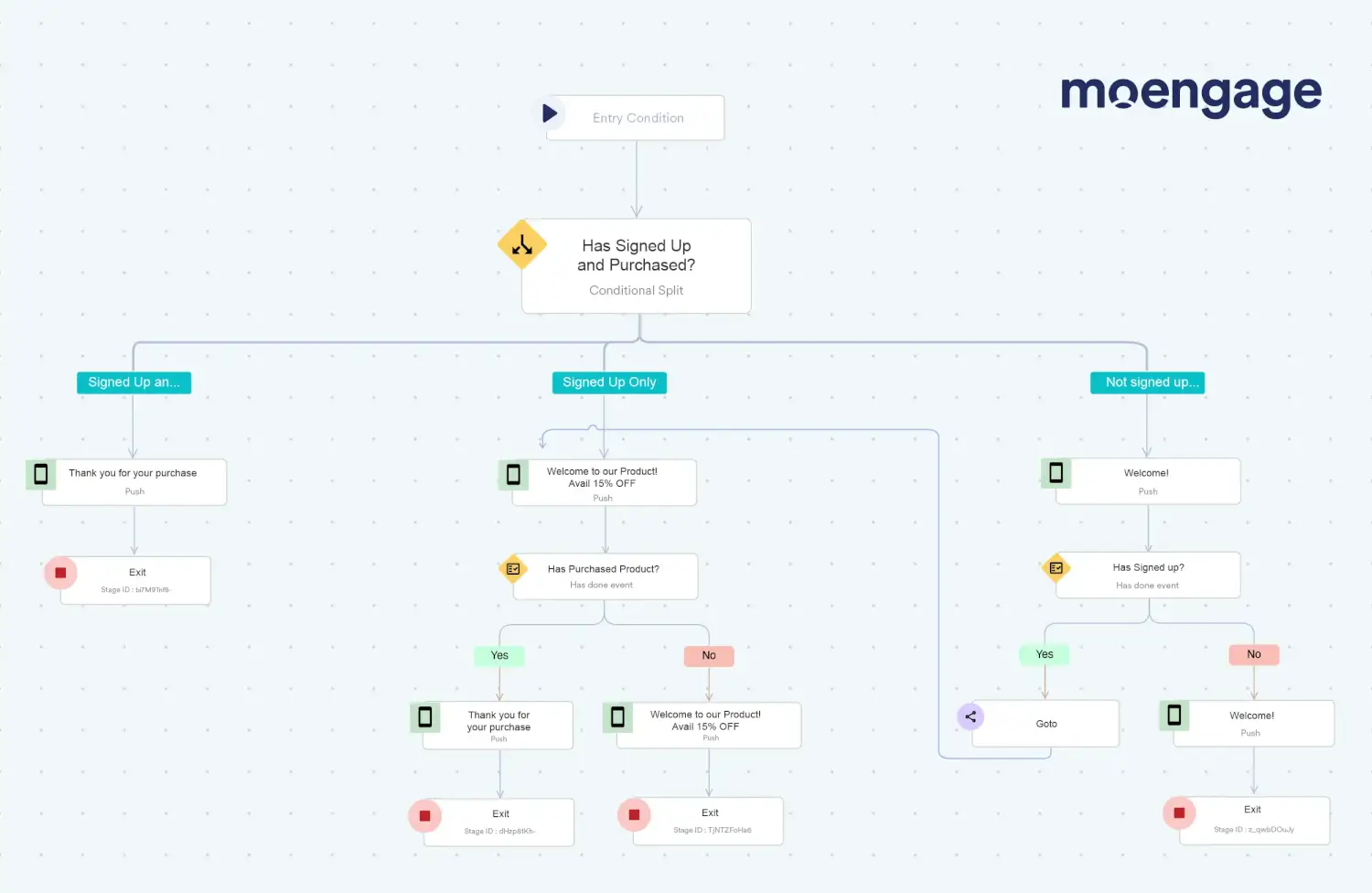
2. Multi-channel Customer Onboarding Flow
A multi-channel approach to customer onboarding ensures you have multiple ways to communicate the value proposition of your product. Mapping this customer journey allows you to identify bottlenecks and drop-off points in the onboarding process and personalize your B2C communication.
| Entry condition: |
|
| Conversion goal: |
|
| Recommended channels / features: |
|
The customer journey template below will help you welcome new customers and use multiple channels to communicate with them.
You can leverage the power of A/B testing to identify the best channel to communicate with new customers (and use this information for other onboarding Flows). This template also employs locales and conditional splits to identify each customer’s preferred language so you can send communication based on each individual customer’s preferences.
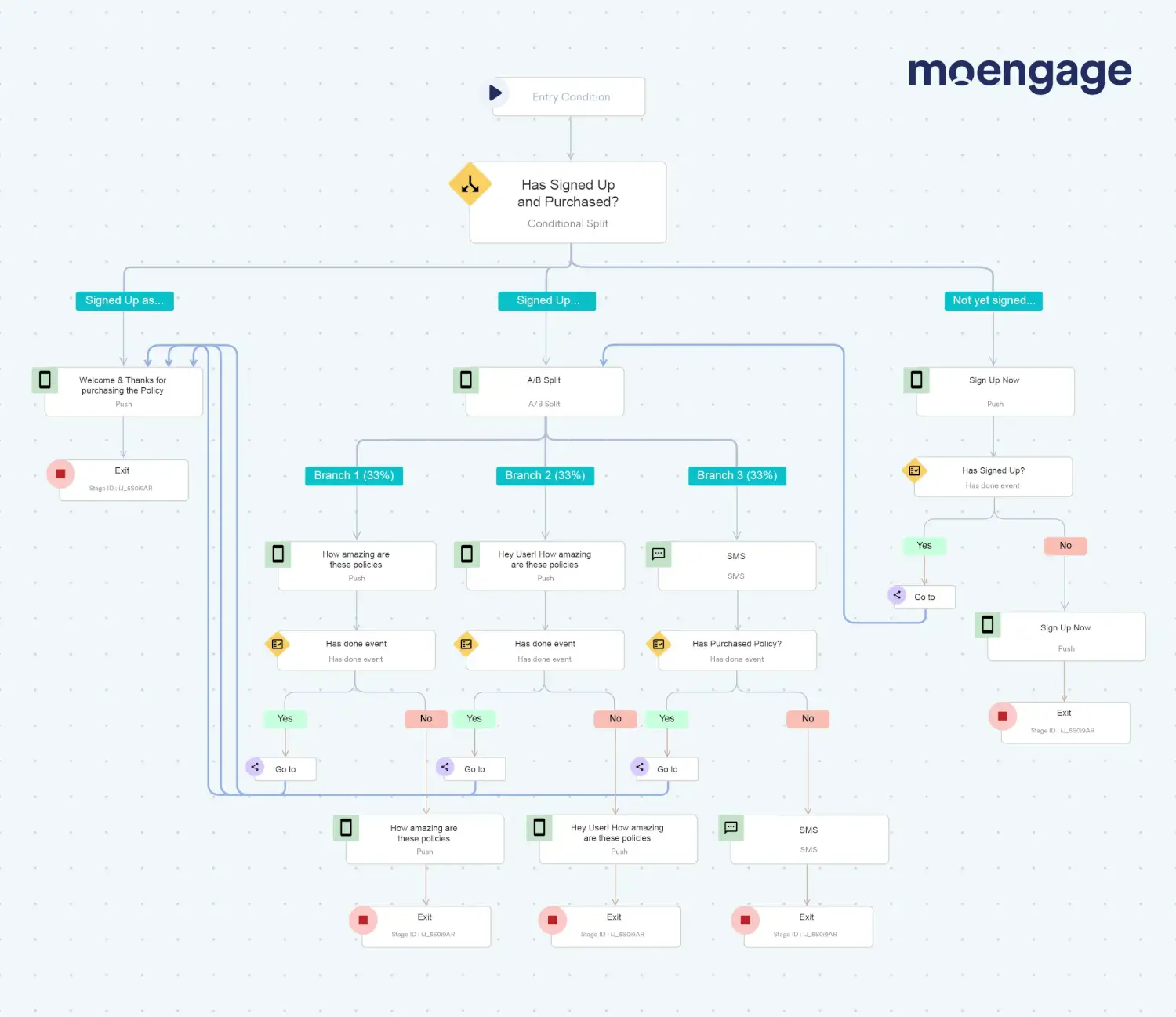
3. Increasing Mobile App Engagement
A high engagement on your mobile app indicates your customers are more likely to make a purchase and rely on your platform to fulfill their needs. Higher engagement leads to higher LTV, better customer loyalty, more referrals, and better customer retention.
To successfully drive engagement on your mobile app, you need to map the customer journey and consider multiple avenues that you can leverage to drive personalized communications.
| Entry condition: |
|
| Conversion goal: |
|
| Recommended channels / features: |
|
Use the customer journey template below to engage with customers who haven’t been active on their mobile app for a few days using Next Best Action. The template uses In-app Messages and Cards to nudge customers toward a conversion goal once they open their mobile app.
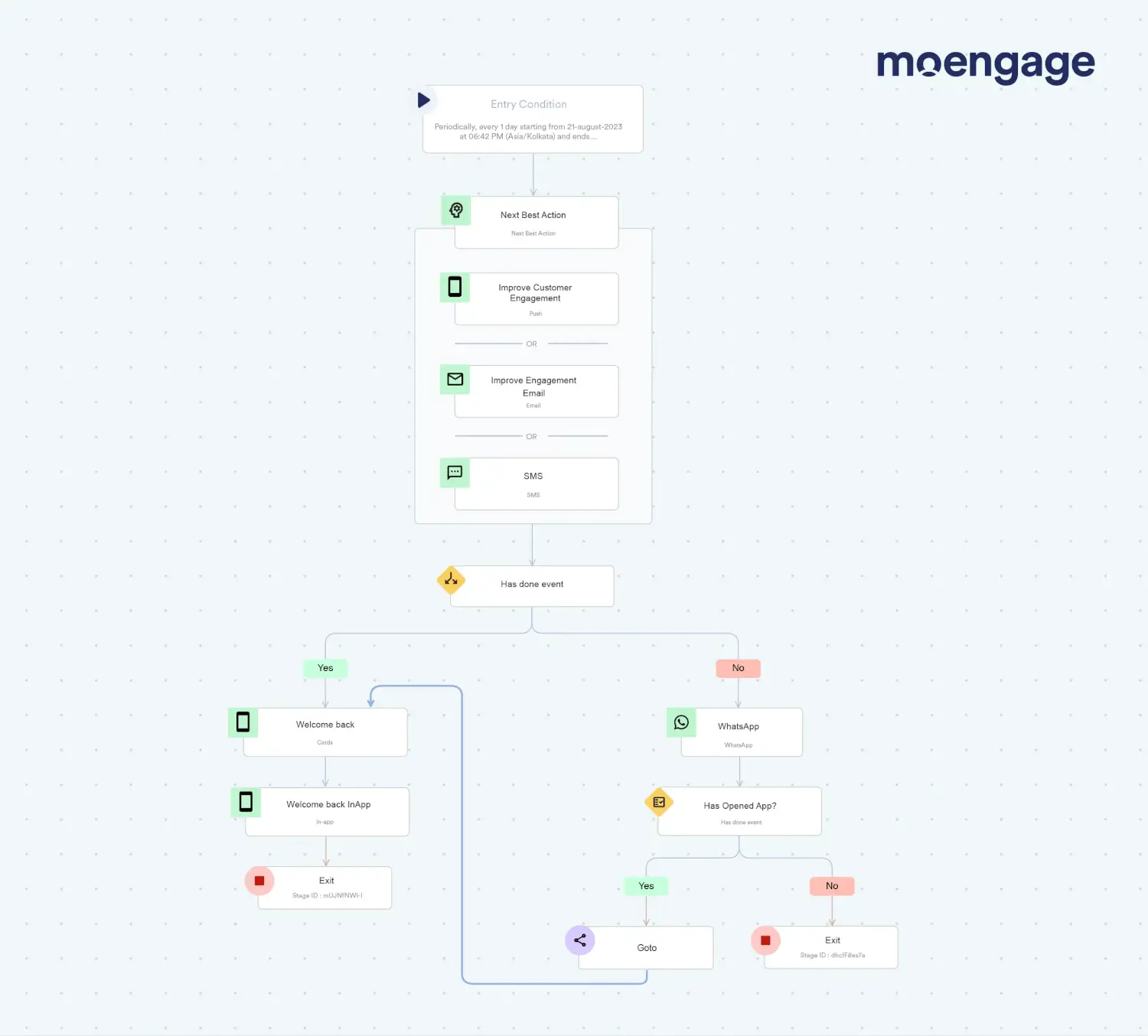
4. Increasing Web Engagement
Similar to mobile app engagement, website engagement plays a crucial role in the growth of your North Star metrics. Mapping the web engagement journey helps you understand customer navigation, preferences, and factors influencing their engagement.
Mapping this customer journey helps you optimize the website effectively by using Website Banners, On-site Messages, and more.
| Entry condition: |
|
| Conversion goal: |
|
| Recommended channels / features: |
|
You can use the customer journey template below to engage with customers who haven’t been active on your website for a few days using Next Best Action. The template uses a combination of Web Push Notifications, On-site messaging, Cards, and Google Ads to nudge customers toward the conversion goal.
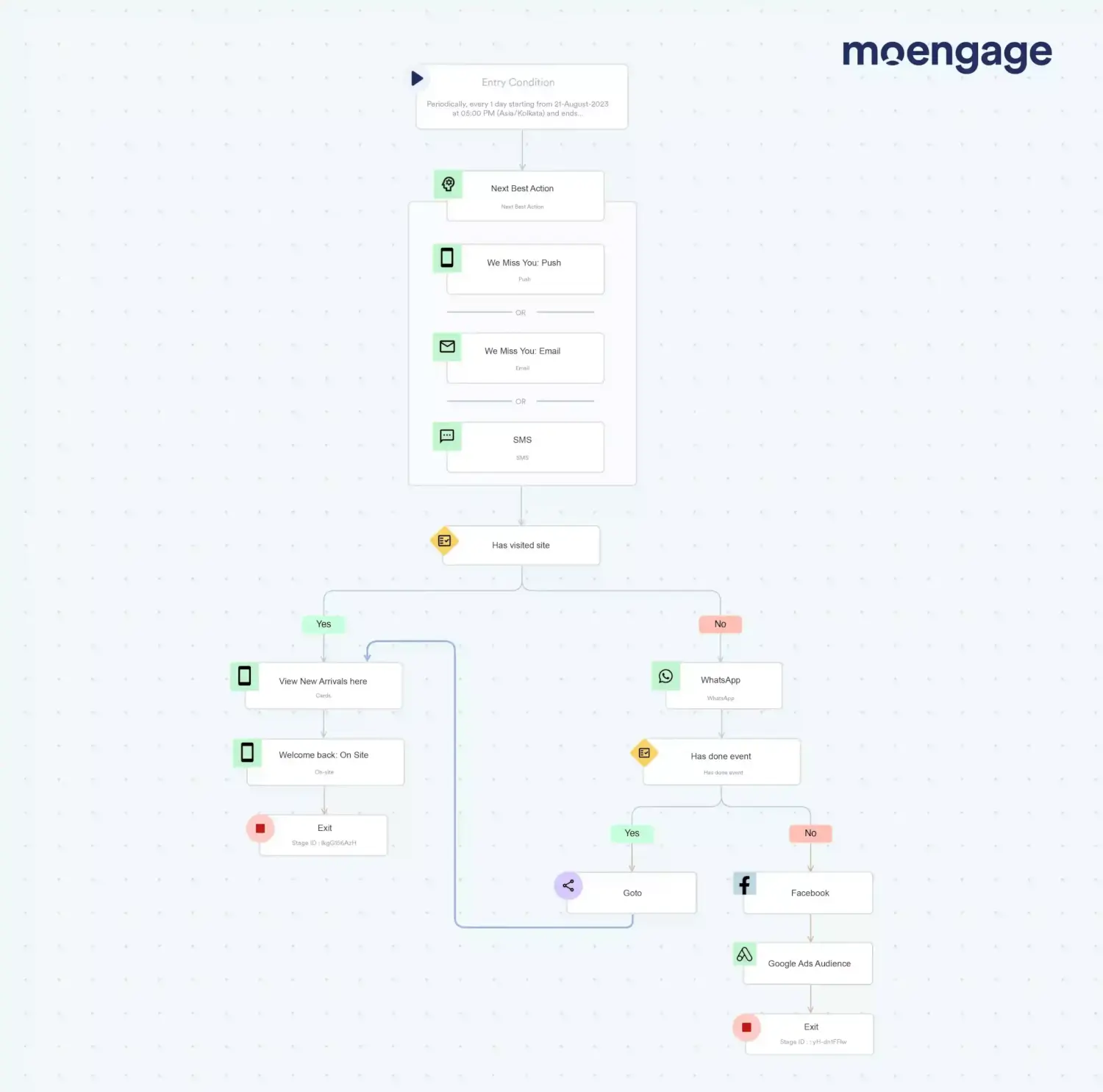
5. Single Channel Abandoned Cart
Cart abandonment campaigns are crucial because they help you recover potentially lost sales by reminding and enticing customers to complete their purchases. Mapping the customer journey for abandoned carts and sending relevant campaigns can significantly improve conversion rates and revenue.
| Entry condition: |
|
| Conversion goal: |
|
| Recommended channels / features: |
|
Use the customer journey template below to send reminders to customers who have added items to their cart but are yet to make a purchase.
The template uses the Wait For/Till Node element to send communication after a time delay and checks if the customer has abandoned the cart or made a purchase post the set interval before sending the communication. This template employs a single channel for communication.
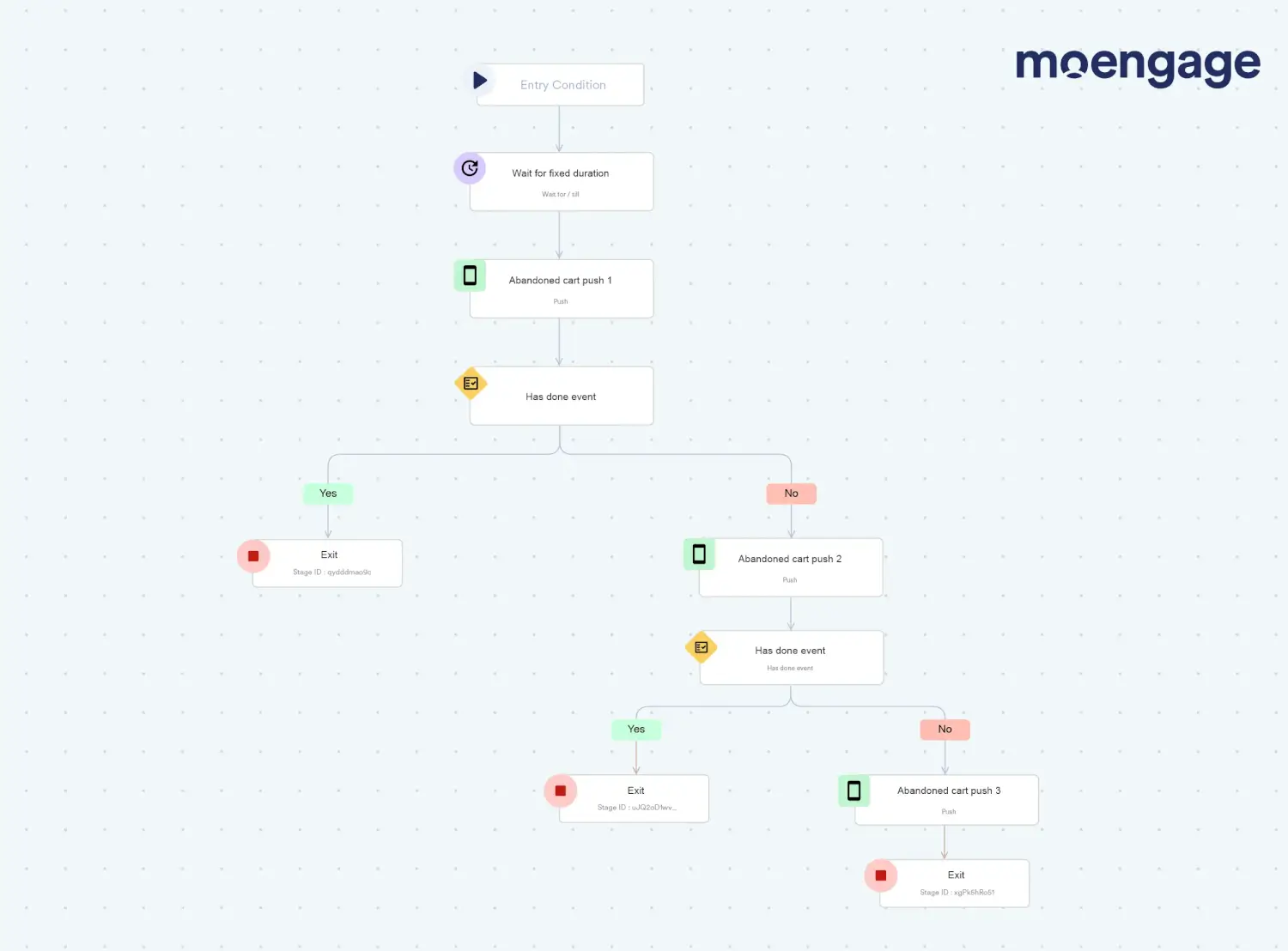
6. Multichannel Abandoned Cart
A multichannel approach to an abandoned cart customer journey allows you to engage customers through various channels like Email, Retargeting Ads, or Push Notifications. Customer journey mapping in this context helps you comprehend where potential customers drop off and which channels are most effective for re-engagement.
| Entry condition: |
|
| Conversion goal: |
|
| Recommended channels / features: |
|
Use the customer journey template below to nudge customers who’ve abandoned their carts towards making a purchase by leveraging multiple communication channels in a single seamless experience.
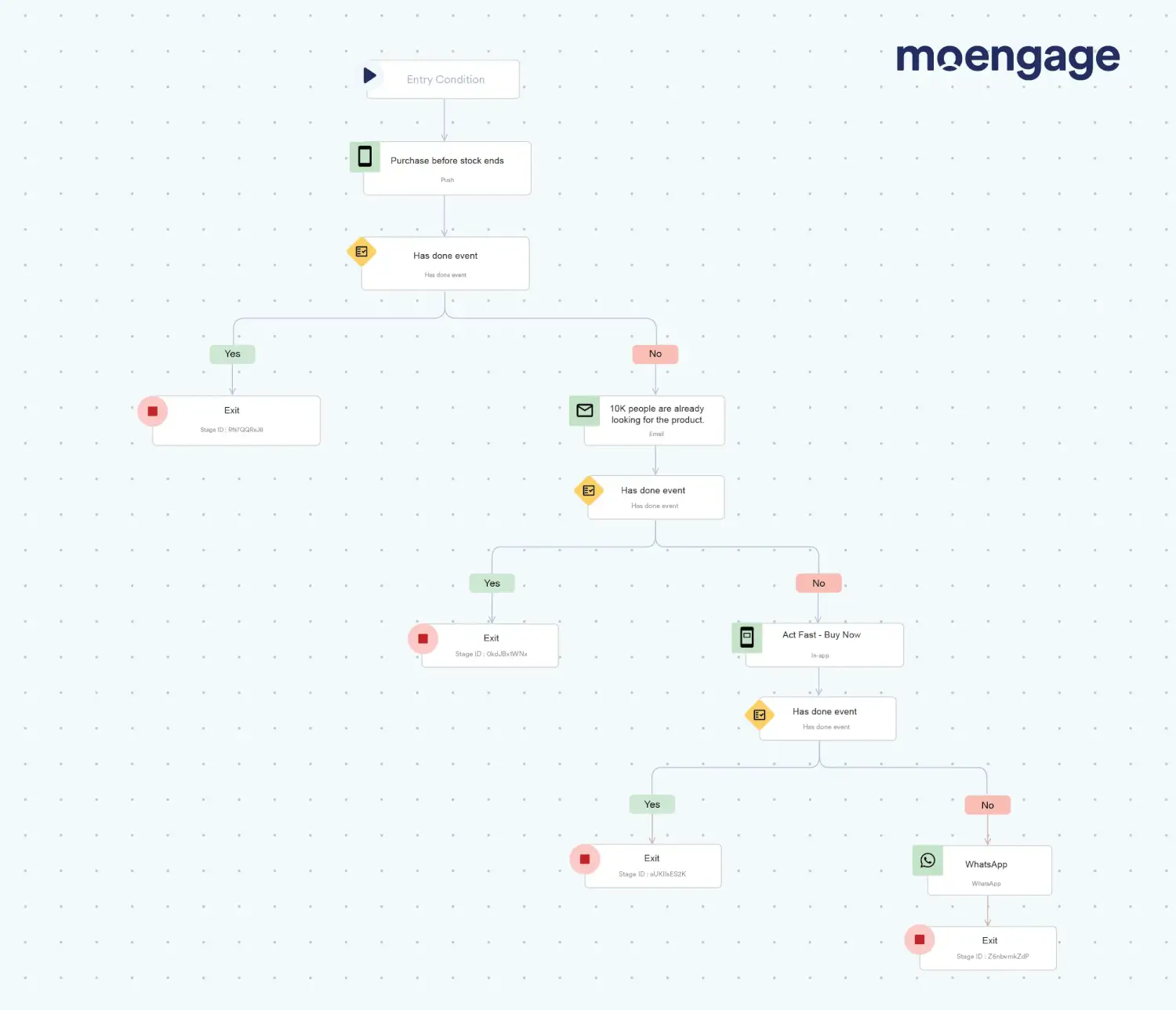
7. Abandoned Browse
Quite often, you will notice that your customer cohort that browses products without making a purchase grows in size. Mapping the browse abandoned customer journey will help you create strategies and ideate personalized campaigns that will help you convert browsers into buyers.
| Entry condition: |
|
| Conversion goal: |
|
| Recommended channels / features: |
|
You can use the customer journey template below to engage with customers who’ve viewed products or looked up specific categories of products but haven’t made a purchase yet.
This template will help you send contextual communication and leverage the power of Intelligent Path Optimizer (IPO) to distribute customers automatically to the best-performing path intelligently using MoEngage Sherpa.
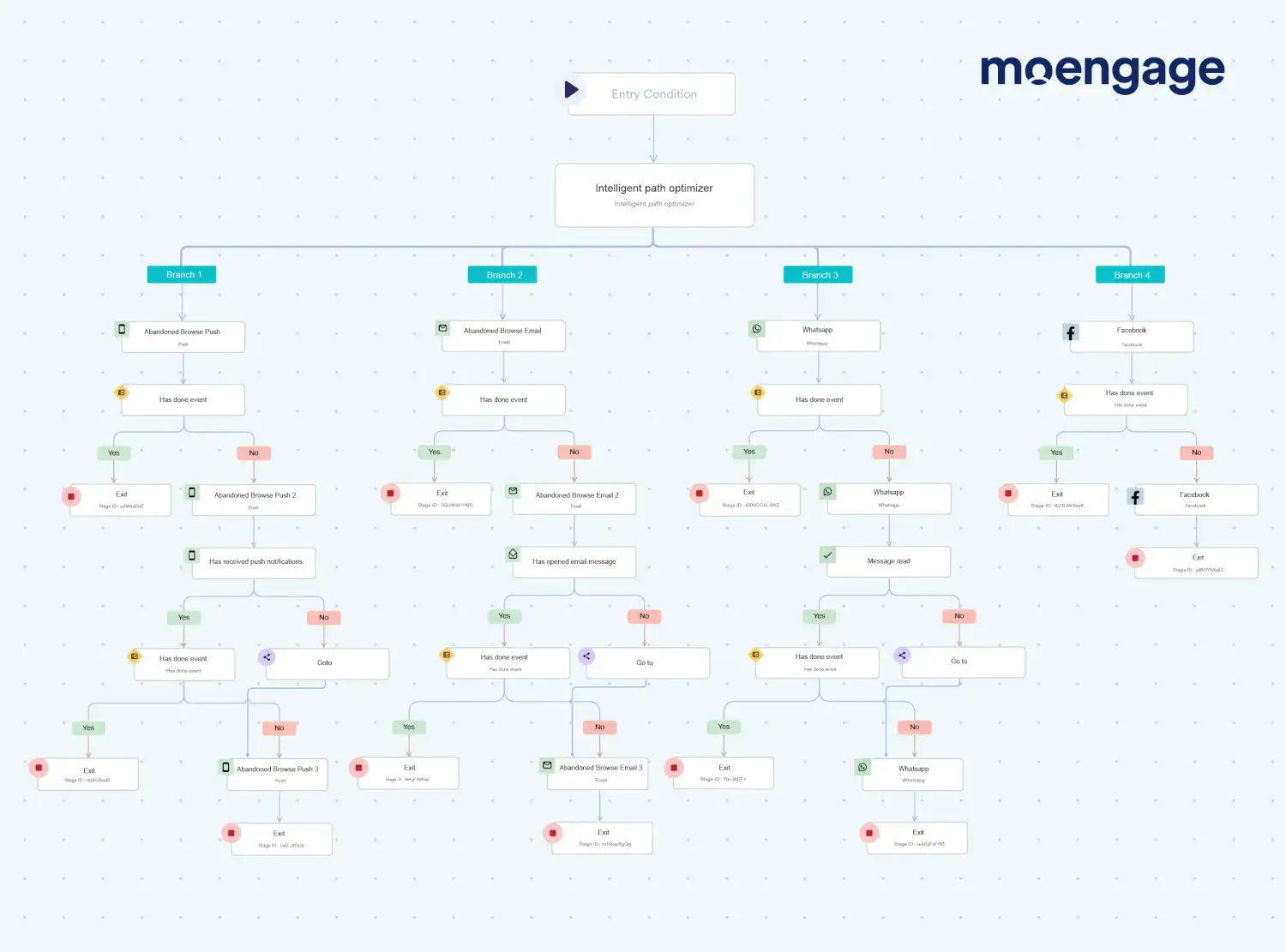
8. Periodic Customer Reactivation Flow
Reactivation campaigns are essential when you want to re-engage your dormant customers who may have lost interest or disengaged from your brand.
By reaching out with tailored incentives and messages, you can use these campaigns to revive customer relationships and boost long-term retention and revenue.
| Entry condition: |
|
| Conversion goal: |
|
| Recommended channels / features: |
|
Use the customer journey template below to engage with dormant customers in a periodic manner (say, every ten days). This template leverages the power of Next Best Action to communicate with each customer in their preferred channel at the time that they are most likely to engage via that channel.
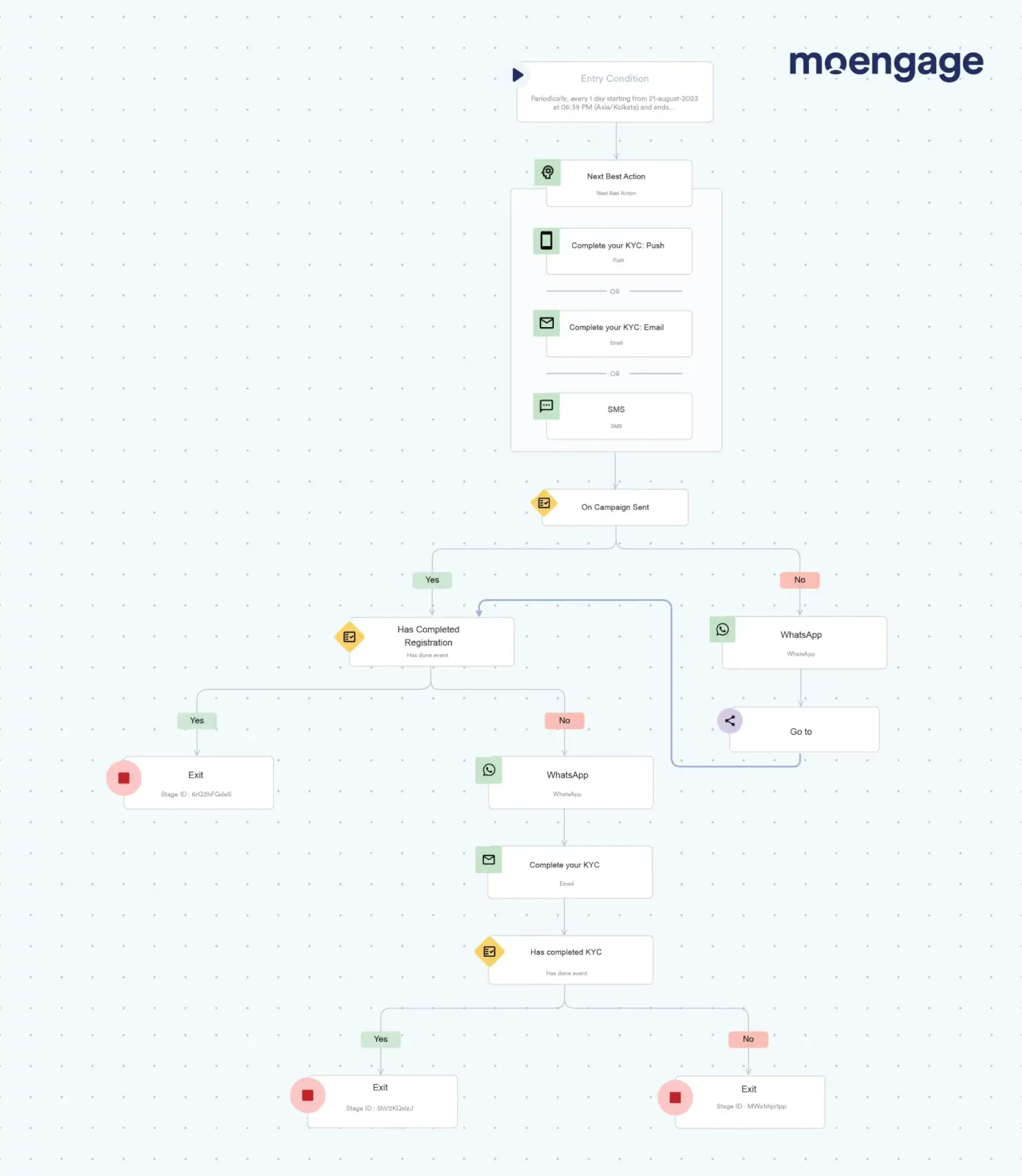
9. Multichannel Customer Reactivation Flow
It is crucial to re-engage inactive customers by mapping their customer reactivation journey. You can send personalized communication and tailored discounts or offers over multiple communication channels to reignite their interest in your platform.
| Entry condition: |
|
| Conversion goal: |
|
| Recommended channels / features: |
|
Use this template to engage with customers who haven’t been active on your platform for quite some time. This template helps you send curated offers and communicate with dormant customers. Since the Next Best Action (NBA) is employed in this template, communication is sent to each customer in the channel that they are most likely to engage with and at the time that they are most likely to do so.
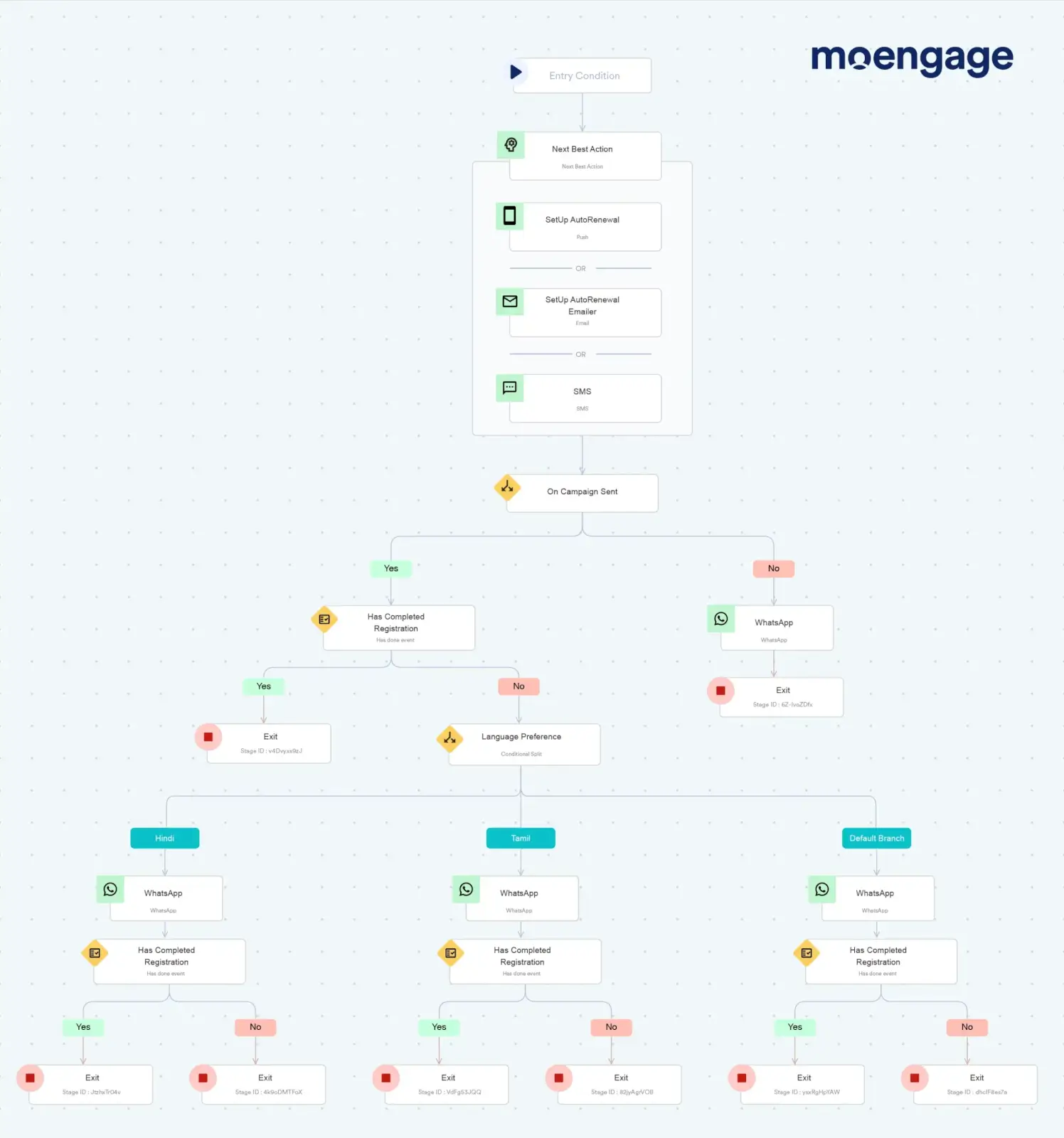
If you want to learn how you can take advantage of any of the customer journey templates above to optimize your own customer engagement efforts, schedule a demo with our team to see these templates in action.
Mastering B2C Customer Journey Orchestration with MoEngage
In today’s customer-centric world, building seamless experiences your customers love is no longer an option — it’s a necessity. To create experiences and campaigns that meet these demands, B2C marketers need to use customer journey mapping to understand when, where, and how customers interact with their brand.
When leveraged properly, these maps can help brands build experiences based on their North Star metrics, guiding them steadily towards their destination.
Since B2C customer journey maps can get so complex, it’s best to start with a template that helps guide you towards your goals as well, helping you build a comprehensive journey map that considers all potential touchpoints and pathways. With our strategically designed, customizable B2C customer journey templates, you can orchestrate complex customer journeys that allow customers to enter and exit at any point in the process seamlessly.
MoEngage not only empowers you to build more encompassing, reliable journey maps, but it also empowers you to do it faster and more efficiently. Schedule a product demo with our experts to learn how we can help your brand develop accurate, reliable journey maps that empower you to build incredible customer experiences, reduce cart abandonment, and increase ROI.








